Mountains and Rain Shadows
Wind blowing into a mountain range cannot go through it. It must go over it. If the air contains enough water vapor and the mountain pushes it high enough, clouds form, and eventually, precipitation falls. As water molecules leave the rising air parcel as precipitation, most of the latent heat of condensation stays with the parcel’s molecules. As it sinks along the mountain’s downwind side, the air becomes warmer and drier than when it began its ascent. When the winds are consistent through much of the year, a rain forest forms on the upwind side and a desert on the downwind side.
Matti created a video discussing how a mountain range can create two drastically different climates on the upwind and downwind sides. Click on the play button to watch, or go here to watch a larger format.
To determine how Earth’s mountains create rainforests and deserts, identify the seasonal wind patterns for a given latitude in the Global Winds section of the Earth, Wind, and Forces software and reviewed in the Global Winds Through Earth’s History.
Notice that the rain occurs on the mountain’s upwind side (or windward side) but not on the downwind or leeward side. Clouds, however, may be on both sides of the mountain. Sinking air does not cause the clouds to disappear immediately. Instead, a cloud disappears once all of the water droplets evaporate.
Note that the software used to create the following animations is a simplified model of precipitation, and the results indicate trends observed along mountains, not accurate values found in nature.

As the wind pushes air up a mountain slope, the air cools, saturates, and cloud droplets grow. When they are too large to stay suspended in the air, precipitation forms and falls from the air.
The following four animations are based on surface air being pushed up the mountain gaining water vapor through evaporation. The surface air temperature remains 25ºC.
Clouds are shown as light gray and precipitation as dark gray vertical lines extending from the clouds to the mountain.
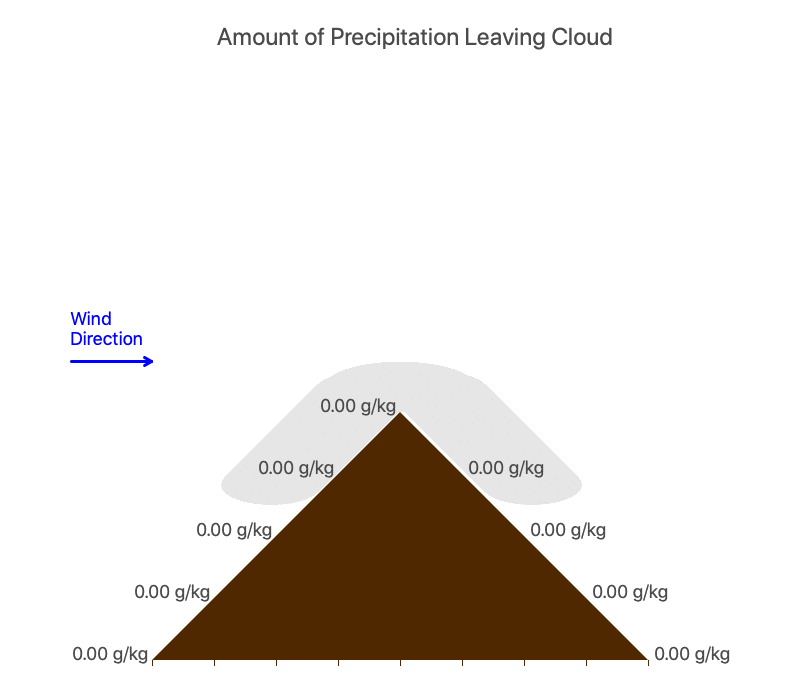
In the animation above, the amount of precipitation leaving a parcel of rising air is shown in grams of water per kilogram of the parcel’s mass. Vertical gray lines show where it’s raining within the light gray clouds.
As the rising surface air becomes more humid, precipitation first forms near the summit, and with continued addition of water vapor, rain forms at lower elevations. Rainfall leaves the remaining air drier. If enough rain falls at lower elevations, there is less water available for precipitation near the peak.
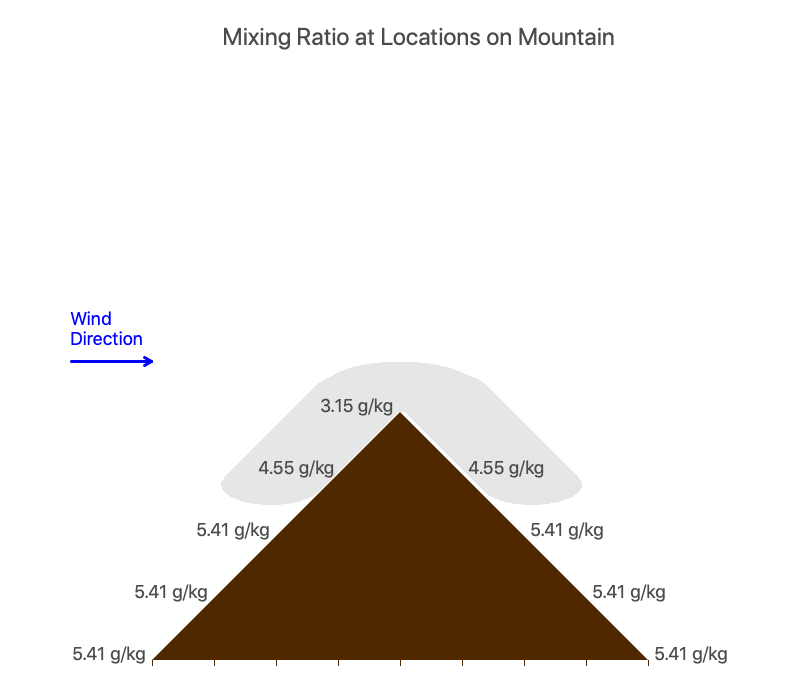
The mixing ratio is the grams of water vapor relative to the kilograms of dry air within a given volume of air. The mixing ratio of rising and sinking unsaturated air remains constant. When a cloud forms, a portion of the water vapor condenses to liquid water, so the mixing ratio decreases. If the cloud evaporates before precipitation taking place, the mixing ratio returns to its unsaturated values. As rain leaves the air, the mixing ratio permanently decreased. When the air sinks on the downwind side of the mountain, it will contain less water vapor than when it started its journey across the mountain.
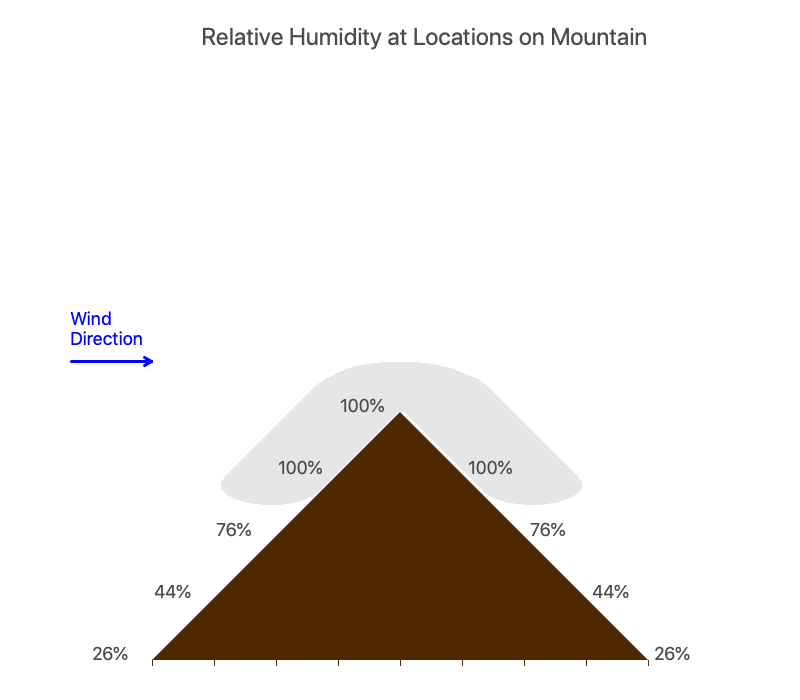
The relative humidity is the amount of water vapor present in the air expressed as a percentage of the amount needed for saturation at the same temperature. Most land-based living organisms are affected by relative humidity. Annually consistent relative humidities allow particular plants and animals to thrive while others won’t. Mountains and persistent wind directions create rain forests on the side with consistently high precipitation rates and deserts in the low relative humidities downwind of the mountain.
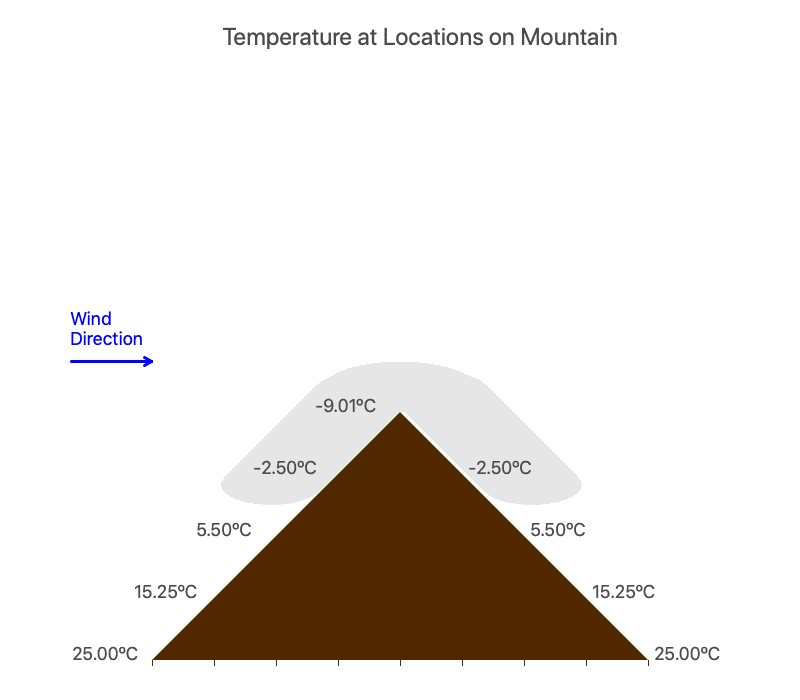
Condensing water vapor releases tremendous amounts of heat to the surrounding air and the cloud droplet. When precipitation falls from the sky, the heated air remains behind. When the air sinks on the other side of the mountain, there is less water to evaporate. Since there is less evaporative cooling than if the precipitation hadn’t occurred, the air will be much warmer at the base of the mountain than when it began its ascent. The more rain that falls, the higher the temperature increase.
Explore Rain Shadows
Use the Mountains section of the Atmosphere, Clouds, and Precipitation software (download available on the software page) to determine the conditions that create the most intense rain shadows.
Where are rain shadows found on Earth? Use this terrain map and your knowledge of global wind patterns from the Earth, Wind, and Forces software to identify their locations.
Can mountains create too much precipitation? Relatively new technology, water vapor-sensing satellites discovered atmospheric rivers, that, when blown into mountain ranges, create catastrophic flooding.
Rain Shadow Effect Changed North America
View the animation of how North American ice sheets changed during the past 21,000 years. The Canadian Rockies, coupled with prevailing winds from the west, created a rain shadow east of the mountains. Between 15,000 and 14,000 years ago, an ice-free corridor formed. Since there was still quite a bit of water stored in the remaining ice sheets, low sea levels created a land bridge called Beringia, between North America and Asia. The lower sea levels and ice-free corridor allowed people to migrate from Asia into North America. Current research using DNA shows that this land bridge allowed people to migrate in both directions: from Asia to the Americas and, once established in North America, from the Americas to Asia. Animals and plants also migrated between the two continents during this time.
Animation of ice retreat across North America since 21,000 years ago. The ice sheets are in blue. Continents, outlined in black, change shape and size as ice melted and sea level rose.
Data are from Pollen Viewer maps created by Williams et al. 2004 Ecological Monographs. The animations on the Pollen Viewer website were originally developed by Phil Leduc, John Williams, Bryan Shuman, and Thompson Webb at Brown University. The original data are in the Neotoma Paleoecology Database (www.neotomadb.org).
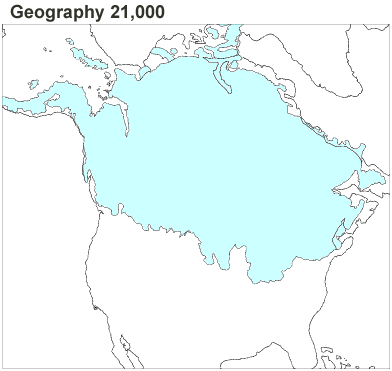

0 Comments